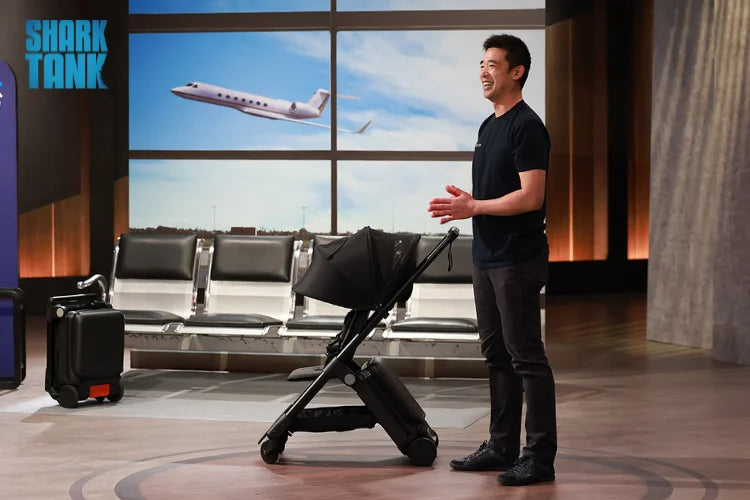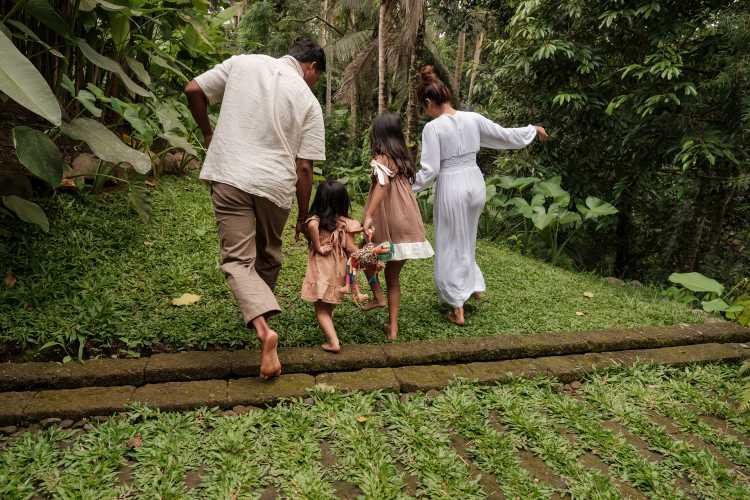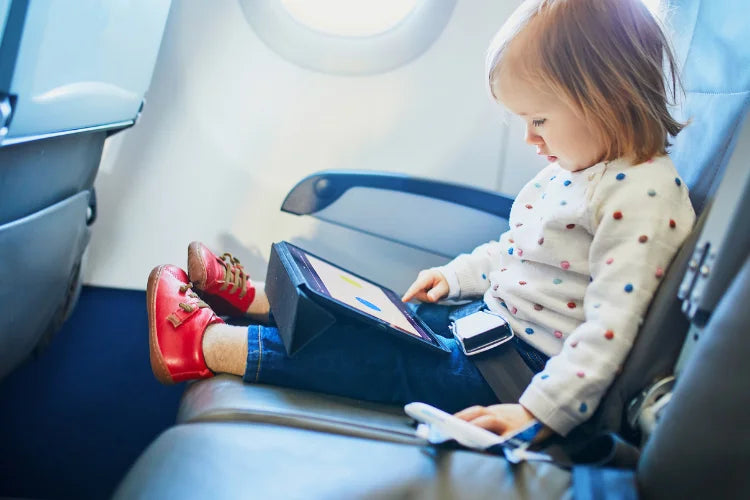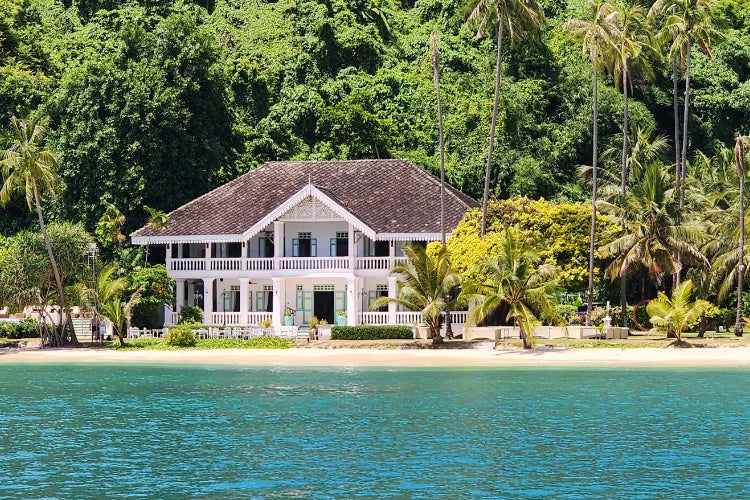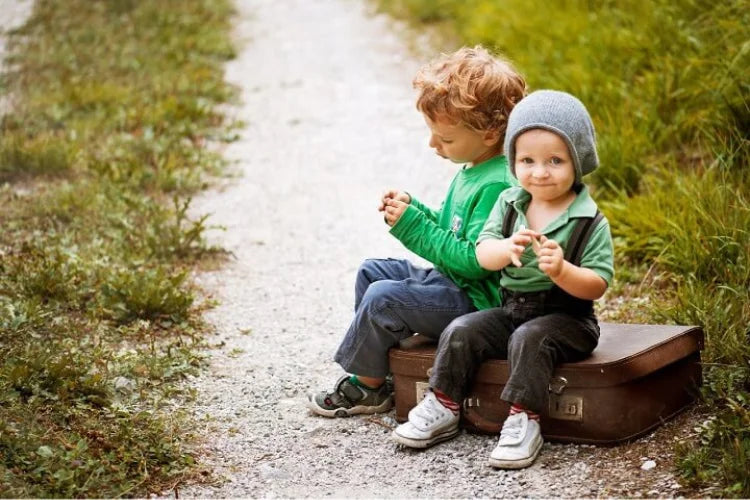Flying, let alone flying internationally with an infant, can be exhausting. Many times, I lay aside flying because I was afraid of flying with little children. Flying with an infant is difficult but not impossible. It all comes down to managing your expectations and planning ahead of time.
All the trouble would be worth it when you look back in time. The bond you share and the experiences you create together are so magical that words cannot adequately express them. I’ve traveled with my kids to more than 44 cities, and I’d like to share my experience with you in order to inspire you and instill in you the confidence that taking an infant on a plane is completely doable.
If you are planning to travel with a stroller, read here for a comprehensive guide on traveling with a stroller.
Perhaps you are open to the idea of traveling with carry on only. Read our article to find out the secrets to traveling with kids and carry on only.

Table of Contents
When Can a Newborn Fly Internationally
Although infants are permitted to fly as early as a few days after birth, healthy full-term infants are best suited for air travel. This is due to the fact that air travel can increase a child’s risk of contracting an infectious disease.
Click here for a list of common illnesses experienced by children when traveling abroad.
If flying is unavoidable, a pediatrician should be consulted prior to booking a flight. Otherwise, it is recommended to wait between 3 and 6 months before traveling internationally with an infant.
Internatonal Travel with Infant: Documents Required for Air Travel
When traveling with children, it is important to have the proper documents ready for a smooth trip. The last thing we want is additional unnecessary stress. That’s where planning comes into play.

Birth Certificate
An infant is not required to have a passport for domestic travel in the United States or Canada. Instead, bring a certified copy of the birth certificate. Having said that, most airlines will likely not request age proof.
Passport
The TSA states that infants born in the U. S. do not require identification when flying domestically. It applies to anyone under the age of 18 or anyone traveling with a lap infant. However, a passport is required for international travel.
Both parents must be present in person for an infant's passport application. If you are the only guardian of a child, you must also provide documentation.
Below are the following documents required:
- Original or certified copy of your child's birth certificate
- A photocopy or certified copy of your US citizenship evidence
- Your passport or driver's licence
- One photo of your child. Click here for photo requirements.
Physician’s Note
When traveling with a lap infant, check with the airline to see if a medical form is required. Every airline has its own set of policies. For example, on American Airlines, infants under the age of seven days must fill out a medical form before flying.
Parental Consent Letter
When flying with a lap infant in the U. S. without all parents or legal guardians, you must present a Child Travel Consent. This letter serves as a permission letter to demonstrate to flight providers and customs officers that both parents consent to their child traveling.
When traveling internationally without both parents with a baby, you may be required to present a travel consent form to airline personnel or immigration authorities.
You can download a sample copy of the travel consent form here.
Proof of vaccination
There may be country-specific vaccination recommendations and requirements depending on your destination. . In Australia, when flying with an infant domestically, you are not required to show proof of vaccination.
When traveling with an infant in the U. S., the earliest opportunity to receive recommended immunizations is when your baby is 6 weeks old. If you are unsure, consult with your clinician.
For extra reading about vaccine recommendations for infants and children, click here.
Traveling with a Newborn by Plane - What Flight to Book?
Generally, I’ll choose the flight time depending on the flight’s duration and how many sectors. It also depends on the temperament of your child.
Day Flight
If the flight time is less than 6 hours, I will take a day flight. I have more energy during the day to care for my baby. Even if my baby stays awake for the entire flight, although tiring, managing my little one during the day is very manageable.
I try to plan my flights around my baby’s sleeping schedule. For example, if their morning nap time is 10:30 am, I will book a flight around 10 am so that by the time we board the plane and settle in, it will be time for a nap.
Of course, many things can be planned ahead of time to make a flight more comfortable. For example, I can reserve a bassinet seat so that my baby can sleep in it during the flight.
Another factor to consider is whether I will be flying with my partner or a parent. Having assistance makes a significant difference. It wouldn’t matter as much with the flight if you had another pair of hands available to take turns with baby duties.
Red Eye Flight
If your baby sleeps well after feedings and is under 6 months old, I will choose a red eye flight for any flights longer than 6 hours, provided I have secured a bassinet seat. As long as your baby is fed and comfortable, he or she will most likely sleep for the majority of the flight.
I will choose a day flight if they are 6-12 months old, can sit up, and are curious about their surroundings. My experience has taught me that my baby is inquisitive between the ages of 6 and 12 months. Even though he is tired, he will experience a surge of energy in this new environment the moment we board the plane. He’ll try to play with the people behind us or touch everything in his path.
In general, it will take some time to get my baby to sleep. Even if I buy a bassinet seat, my baby will try to sit up and climb out. As a result, taking a day flight at this age was easier so that I could look after my baby if he decided not to sleep.
Traveling with an Infant - Do They Fly Free?
Flying with an infant on the lap
Although you may have heard that flying with a lap infant is free, this is not true when flying internationally. When flying with a baby under the age of two, you can have your baby share a seat with you as a lap infant. Generally, you pay 10% of the airfare flying with a lap infant.
When traveling with a partner or family member, you may be able to get an entire row to yourself, giving you more space. The trick is to reserve a window and an aisle seat while leaving the middle seat empty. People are less likely to choose a seat in the middle. So there’s a chance you’ll get a free seat. Otherwise, if someone ends up having a middle seat, it is easy enough to swap seats with them on the plane.

Things to know about airplane bassinet for your baby
- Airplane bassinets are first come, first serve. Some airlines do not allow you to book a bassinet and leave the bassinet to the youngest traveler on the day. Check with your airlines in advance
- Reserve the specific seats that allow you to book a bassinet
- Bassinets are not available on all flights
- Bassinets are not allowed to be used during take-off and landing
For more information on airplane bassinets, read here on an in depth guide about booking airplane bassinets.

There is also the option of purchasing a seat for your infant. In this case, your infant pays the full price. Every adult is permitted to have a lap infant. So, if you’re traveling alone with twins, you’ll have to pay the full fare for one of your babies.
Purchasing a seat for your infant
There is the option to purchase an infant seat for a more comfortable flight. You will pay full price for your baby’s seat, but you may bring a car seat onto the plane. If you decide to bring a car seat, ensure that it is Federal Aviation Administration (FAA) approved.
For more reading on Child Restraint Systems (CRS), click here.
Travel Gear to Bring Along
When traveling with an infant, the more hands you can free up, the better. Therefore, carefully consider what you will need when flying with an infant.
It is also important to categorize our belongings in order to make our lives easier, especially when going through security.
Here are a few items I consider non-negotiable when traveling with an infant.
Baby Carrier
Babywearing promotes bonding and creates a calm environment for your child. As a result, using a baby carrier in a busy and noisy airport helps to calm your child. Using a baby carrier also frees up your hands, making it easier to access your boarding pass or valuables when needed.

You are allowed to babywear your child when going through security. So I usually carry my diaper bag, fold down the travel stroller, and go through security while babywearing my child.
For more information on the best baby carriers, read here.
Diaper Bag
Invest in a diaper backpack for travel and use it as a carry-on for one parent. Using a diaper backpack not only allows you to travel with fewer bags, but it also frees up your hand to care for your child.

Simply familiarize yourself with TSA regulations regarding carry-on luggage. It is important to note that airlines do permit the carriage of diaper bags, breast pumps, and car seats.
Formula and breast milk may be carried on board and are exempt from the TSA's 3.4 ounce liquids rule. Note that they will be individually screened and subject to additional security checks.
Carry on Luggage Stroller
I recommend bringing a carry on luggage stroller when traveling on multiple flights with layovers. This hand luggage stroller allows you to carry your belongings and keep your child close to you at all times, especially in the event of a flight delay.
A carry on luggage stroller provides additional storage space for all of your baby’s necessities. And when your child is exhausted, they can nap there.
Car Seat
The FAA recommends that infants and children weighing less than 40 pounds be secured in an appropriate Child Restrained System (CRS) when flying. Ideally, if your budget allows, you should reserve an extra seat for your baby.
In this situation, bringing a car seat for your baby on the flight will make everyone more comfortable. Check the label on your car seat and make sure it is FAA-approved prior to boarding your flight.
Fore more information on the best car seats for airplane travel, read here.

4 Tips for Flying with an Infant on Plane
Change Your Baby's Diaper Before You Board
Due to the difficulty of changing diapers on an airplane, it is recommended that the number of diaper changes required on any given flight be kept to a minimum. To accomplish this, plan a diaper change at the airport as close to boarding as possible. Airport restrooms have significantly larger change stations and more room to maneuver.

A family traveling with a lap infant is usually allowed to board the plane first. This eliminates the need to fight your way through crowds to get to your seats, making it easier to get everyone settled.
Boarding

Board The Plane Separately When Flying Together
When flying with two adults and a lap infant, my motto is to split and conquer. Allow one parent to board the plane with all carry-on luggage to give you time to set up the environment and secure the car seat if you’re bringing one. The other parent will board last while the baby is still in the stroller. This allows them to use up excess energy at the gate until the very last second before boarding.

Feed Your Newborn During Both Take-Off and Landing
Now that you’ve boarded, remember to feed your child during take-off and landing. Infants have difficulty understanding how to equalize ear pressure, so feeding counterbalances the change in cabin pressure that causes ear pain. This hack alone is invaluable. If it is not feeding time, a pacifier may come in handy.
Babywear Your Infant if You Did Not Secure a Bassinet
Except for take-off and landing, babywearing is permitted on the plane. When your baby has trouble settling, it may be a good idea to babywear him or her. Close contact and the ability to rock your baby can help soothe and put them to sleep.

Travel Internationally with Your Infant
I hope you found these tips helpful. It is entirely possible to fly internationally with an infant. It will greatly aid your journey if you plan ahead of time. This is a quote I’d like to share with you.
“There is nothing that can change the past and no amount of worrying that can change the future.” Plan that vacation and make wonderful memories with your family.
Read here for information on how and what to pack in your diaper bag, and if you are considering flying with a stroller, this article will provide you with great information.
Safe travels.




